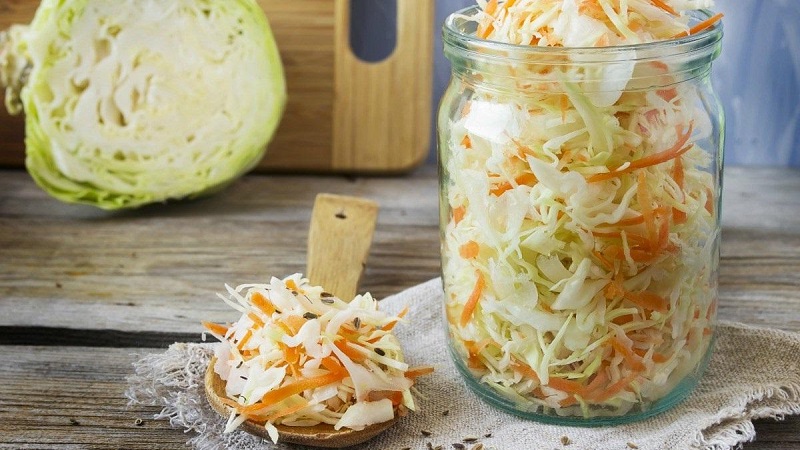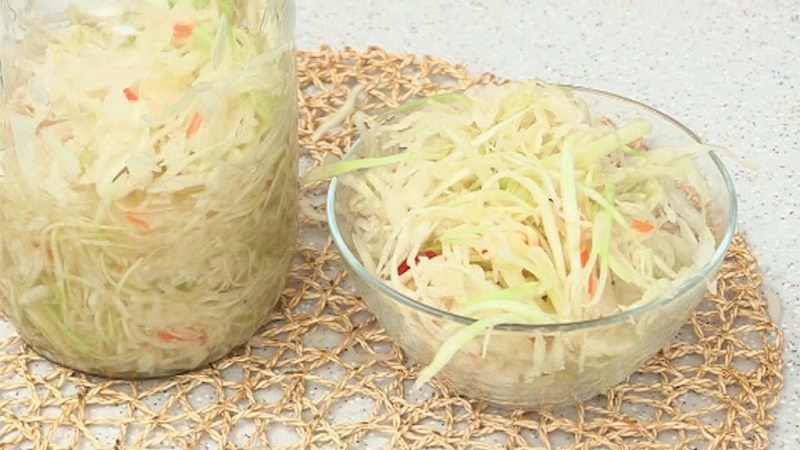What to do if sauerkraut has become slimy and why it happened
Sauerkraut is a visiting card of Russian national cuisine. This product is not only tasty, but also useful: it contains bacteria that support the optimal microflora of the gastrointestinal tract, as well as a large amount of ascorbic acid, which is especially necessary in the winter-spring period. However, the mucus found in the brine completely discourages appetite and raises doubts that the dish is suitable for food.
We will tell you why mucus appears during salting, and the brine in the cabbage stretches and what to do to save the workpiece.
The content of the article
Why sauerkraut has become slimy
The main reason for the appearance of mucus in sauerkraut is the activity of pathogenic microflora. The process of salting itself is accompanied by the release of lactic acid bacteria.
When their number exceeds the norm or foreign microorganisms join, the taste of the finished dish, its appearance and even safety are questionable.
Unsuitable containers
Sauerkraut - an original Russian dish... For its preparation, our ancestors used wooden barrels. Such containers are still considered the most suitable for salting, but it is not easy to get them. It is problematic to store barrels in an apartment, as they take up a lot of space.

Modern housewives for pickles most often choose enameled, glass and plastic dishes. The safest material on this list is glass. To avoid the appearance of fungus and mucus, the containers are cleaned.
Enamel buckets, basins and pans are carefully inspected for chips. If any, the brine will react with the bare metal. Among the unenamelled metal utensils, preference is given to items made of stainless steel without added nickel. Cabbage is salted in stainless steel, but for long-term storage, the finished product is transferred to glass jars.
Plastic containers for winter stocks are best avoided, as the material may be toxic. As a last resort utensils are acceptable made of food grade plastic, but it is strictly forbidden to use plastic buckets for non-food products. The corresponding markings are indicated on the bottom of the container.
Reference. In addition to verbal designation, pay attention to the triangle sign in the form of three arrows and the letter code below it. Polymers with the designation 2HDPE and 5PP are safe.
Unsuitable varieties
Salted mainly mid-season and late cabbage varieties... They are juicier and sweeter, since the long vegetative period contributes to the accumulation of sugars - a necessary component of fermentation.
With a lack of sugar, the fermentation process will be delayed... It will take more time for lactic acid to form, and in a non-acidic environment, foreign bacteria will feel at ease and spoil the brine - it will become slimy and stringy.
Reference. It is easy to distinguish cabbage suitable for harvesting by eye: it has a strong large head of cabbage made of white leaves. In early varieties, the forks are loose and the leaves are green.
Poor quality additional ingredients
The classic sauerkraut recipe uses carrots... The bright root vegetable makes the dish prettier and serves as an additional source of sugar.

There are options with apples, sour berries (lingonberries or cranberries), various spices (caraway seeds, bay leaves, etc.), beets, bell peppers and even watermelon.In order not to introduce extraneous fungi and bacteria into the salad, all ingredients are thoroughly washed and dried. Cotyledons and cuttings are removed from apples, extra branches from caraway seeds and berries. Root crops are placed in the workpiece peeled from the skin.
Some of these products increase the acidity of the environment, others lower it. The speed of fermentation and the quality of the brine will depend on this.
The technology adopted at food enterprises allows the following proportions:
- 3% carrots;
- up to 8% apples;
- 2% cranberries or lingonberries;
- 0.03% bay leaf;
- 0.05% cumin.
A must-have ingredient in sauerkraut — salt... Ideally, a large stone one. Iodized salt acts as an antiseptic and prevents lactic acid fermentation. Due to the slow fermentation in the brine, mucus appears, and the cabbage itself becomes soft and unappetizing.
Important! Do not use spoiled products. Even if you cut out the pieces affected by rot, bacteria and fungi will remain on the apparently healthy areas.
Violation of sourdough technology
During the fermentation process, maintaining the proportions of ingredients and temperature conditions plays an important role. at different stages of fermentation.
Cabbage becomes "snotty" if the following mistakes are made:
- Incorrect temperature. During the period of intensive reproduction of lactic acid bacteria and the accumulation of lactic acid, the optimum temperature is + 17 ... + 22 ° C. If it is higher, foreign microorganisms will appear in the brine, if it is lower, fermentation will slow down. For additional leavening and storage, natural or artificial cold is required - 0… + 2 ° C. Otherwise, mold and filmy yeast develop in a lactic acid environment.
- Violation of the recommended brine strength: 2% for shredded and chopped cabbage, 4% for whole heads. The high concentration of salt prevents the development of organisms necessary for fermentation: yeast, intestinal bacteria and others. In a weak brine, on the contrary, there are too many lactic acid bacteria.

Other errors
There are a number of nuances that affect the quality of sauerkraut.:
- If the chopped leaves are not crushed before salting to release the juice, the formation of lactic acid from the sugars will be delayed, and the pickles will become mucus-covered.
- For the sourdough process, outside air is restricted. For this purpose, the cabbage is covered with a wooden circle and oppression is set. However, in the process of fermentation, gases are formed, which must be periodically released from the container - pierce the cabbage mass with a wooden stick or the handle of a spoon.
- Cabbage sour with insufficient brine... If a day after the installation of oppression the vegetables are not completely covered with liquid, the brine is prepared separately and the workpiece is poured into it.
How to save a workpiece
If mucus appears during fermentation, adjust the strength of the brine and temperature conditions:
- All the liquid is drained from the cabbage, salt is dissolved in it and poured again.
- The capacity is removed from the source of additional heat - batteries, stoves, windows on the sunny side. And at the end of fermentation, they are stored in a refrigerator or in a dark and cool place at a temperature not exceeding + 2 ° C.
These actions will help to complete the process without losing the taste and aesthetic qualities of the product.
If, however, that salted cabbage lasts, it became known after the fact, just before serving it is washed on the table under running cold running water. But in this case, the taste of sauerkraut will be more bland.
Interesting on the site:
The most common mistakes when pickling cabbage
Is it possible to eat slimy cabbage
The issue of the edibility of slimy sauerkraut worries many. Technologists say that such a product is safe if the mucus is free of mold and a strong unpleasant odor... It is enough just to rinse the cabbage.

If in doubt, the product is cooked: boil sour cabbage soup, make bigus (stewed cabbage with meat), use it as a filling for pies. Under the influence of high temperatures, bacteria will die, and the taste of the cabbage itself will improve.
How to avoid slimy cabbage: tips and tricks
To prevent mucus from forming in sauerkraut, you must strictly adhere to the recipe and the following rules:
- for harvesting, choose high-sugar varieties of vegetables - mid-ripening and late-ripening;
- carefully sort and clean all the ingredients, avoiding rotten specimens;
- use coarse or rock table salt - it enhances the release of juice from plant cells and regulates the reproduction of microorganisms;
- observe the optimal salt concentration - 1 tbsp. l. for 1 kg of chopped cabbage;
- do not tamp the cabbage to the edges of the container so that the juice released under pressure does not flow out;
- maintain temperatures up to 22 ° C during fermentation and up to 2 ° C when storing sauerkraut.
Conclusion
If mucus forms during sauerkraut, it is not necessary to throw out the workpiece. Most likely, the cause was the increased activity of lactic acid bacteria. Such a product is not hazardous to health, and an unattractive consistency can be masked by washing or heat treatment.